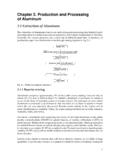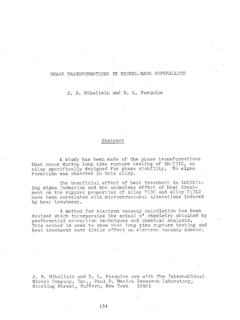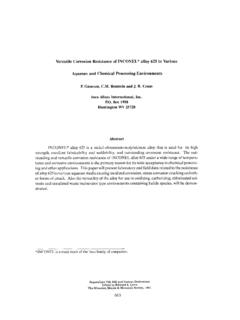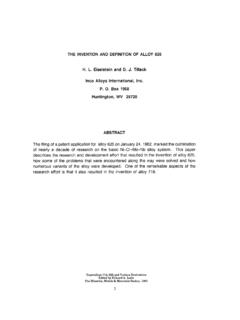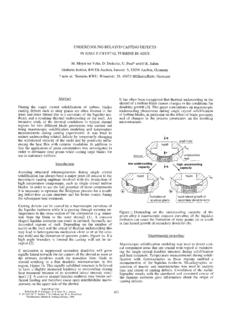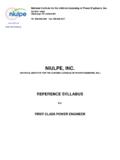Transcription of Characterization of Freckles in a High Strength …
1 Characterization OF Freckles IN A high Strength wrought nickel SUPERALLOY Paul D. Genereux and Christopher A. Borg Pratt & Whitney United Technologies 400 Main Street East Hartford, Connecticut 06108 Abstract nickel base superalloys , such as Gatorizable Waspaloy@, U-720@, and Rene 88@ contain relatively high weight percents of hardening elements ( Al & Ti), for a conventionally cast (VlM/VAR or VIM/ESR/VAR) and wrought (press and or rotary forged) product. Due to the higher volume fraction of gamma prime, this class of alloys has increased susceptibility for the formation of melt segregation defects, such as Freckles .
2 The propensity for freckle formation is further aggravated by the need for larger diameter ingots to support the trend toward higher thrust large diameter fan engines used on wide body twin engine aircraft. A review and assessment of production quality control techniques for freckle inspection are discussed. An in depth microstructural, chemical, and structural Characterization is presented. The effects of freckle defects on key mechanical properties for the design of critical rotating engine components are shown. Finally, a brief discussion of a root cause investigation on the origin of freckle formation in this alloy class is given.
3 Gatorizable Waspaloy@ is a trademark of United Technologies Corporation U-720@ is a trademark of Special Metals Company Rene 88@ is a trademark of the General Electric Corporation Introduction Vacuum arc remelting (VAR) is the most commonly used process for the remelting of superalloys . The VAR process involves the continuous melting of a consumable electrode, typically cast in a vacuum induction melting (VIM) furnace or the product of an electroslag remelt (ESR) process. Melting is achieved by the striking of a DC arc under vacuum between the electrode and the melt pool.
4 The melt pool solidifies in a water-cooled copper crucible. VAR turnace design has remained largely unchanged since its inception in the late 1950s. The significant advances came from furnace controls and in the area of automation of the melting and process control through the selection of optimum melting parameters. The primary benefits to the vacuum arc remelting process are: elimination of pipe, the removal of dissolved gases, the reduction of oxide inclusions, minimization of detrimental trace elements due to their high vapor pressure, and chemical uniformity.
5 Due to the physics of the process, consumable electrode melting also is associated with unique melt related defects in the form of solute segregation such as tree ring patterns, white spots and 19 Freckles . Segregation resulting in tree rings is not considered to have a significant effect on mechanical properties; however, the latter two are generally considered to be detrimental. White spots, as the name suggests, appear as light etching regions and are generally lower in alloying elements ( , Ti or Nb). The formation of white spots is generally considered to be caused by one of the following three elements: 1.
6 Fall-in of shelf or crown material into the melt pool, 2.) fall-in of unmelted dendrites from the consumable electrode, and 3.) localized decrease or arrest in the solidification rate. White spots are considered to be an unavoidable consequence of VAR processing. The primary goal for the melt source in controlling white spots is to minimize the occurrence and severity. Freckles are characteristic of a deep melt pool causing interdendritic channeling of low-density element ( , Al and Ti) rich liquid. Other factors that may lead to tieckle formation are disruptions in electromagnetic fields and variation in heat transfer rates in the melt pool and mushy zone.
7 Freckles are generally continuous and longitudinal in orientation and show up as dark etched spots in a macro-etched They are most commonly, but not exclusively, found at an approximate mid- radial location in the ingot. Freckles consist of high concentrations of hardener elements ( Ti or Nb) similar in chemistry to gamma prime (r ). Detection of Freckles in both ingot and partially or fully converted billet form can be very difficult due to poor etch contrast, density similarities to the base metal, and the tendency not to crack even after significant ingot reduction.
8 Significant work has been conducted to gain a better understanding of freckle formation during the VAR This work has focused on the elimination of Freckles in the ingot through the use of tight process controls. The primary concerns with freckle containing material are the microstructural and chemical variations, which may result in the formation and concentration of phases significantly harder than the base metal. This high concentration of hardening elements has the potential to be detrimental to mechanical properties because of the presence of local hard and possibly brittle regions that may act as crack initiation sites.
9 Limited literature is available which quantifies these chemical composition and hardness differences and especially the property debit associated with freckle defects. Specifically, very little literature exists regarding this type of melt SoperaIloys 2ooo Edited Pollock, Kissinger, Bowman, Green, M. McLean, S. Olson, and Schirra TMS (The Minerals, Metals &Materials Society), 2ooO defect in the class of wrought , high volume fraction y subsequently sectioned and the detailed metallurgical evaluation superalloys , which defines Gatorizahle Waspaloy.
10 Commenced. Industry trends over the past several decades have pushed the envelope for achieving higher Strength wrought alloys at larger ingot diameters. These trends have been largely fueled by the inherent cost and cleanliness benefits that modem wrought alloys have over powder metal product and by improvements in conventional melting and conversion techniques. wrought nickel based superalloys , specifically those containing relatively high percentages (> 35% by volume of y ) of hardening elements ( , Al and Ti), tend to be more susceptible to freckle formation due to the relatively narrow melt window for this alloy classification ( Gatorizable Waspaloy, U-720, Rene 88, etc.)

